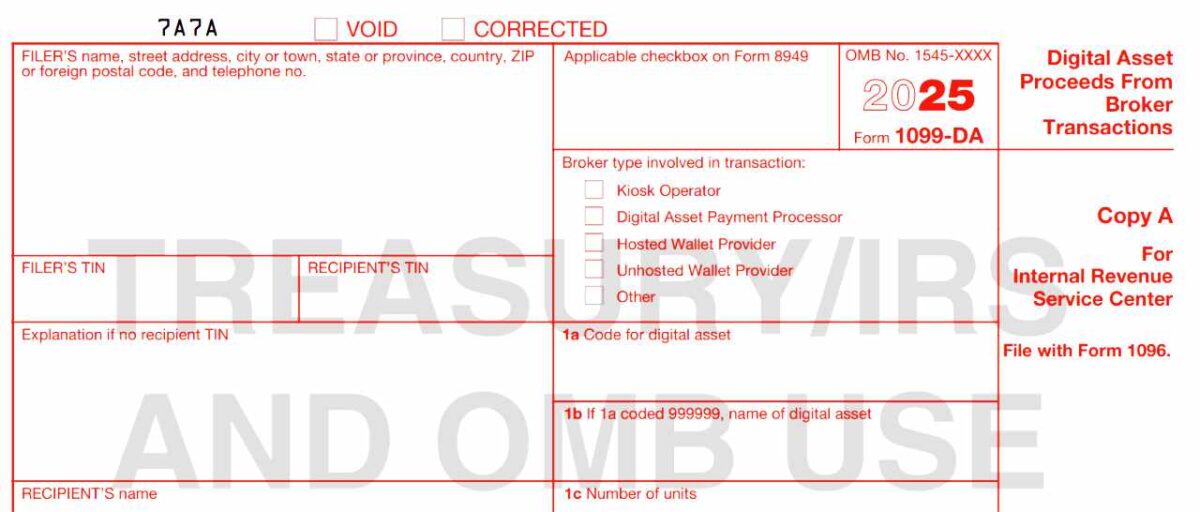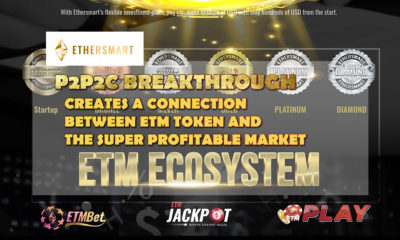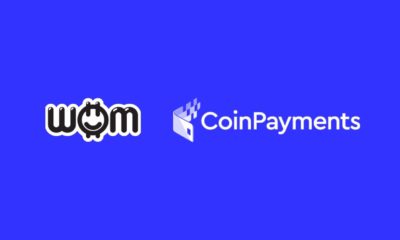Crypto
US IRS Releases Draft of 2025 Digital Asset Reporting Form for US Taxpayers

The Internal Revenue Service (IRS) has taken a major step forward in the evolution of taxation of digital assets by releasing a draft of the 2025 Digital Asset Reporting Form for U.S. taxpayers. This initiative is aimed at enhancing compliance and oversight in the rapidly growing digital asset market.
As cryptocurrencies and other digital assets play increasingly prominent roles in the global economy, this new form will be crucial for both taxpayers and the IRS to ensure accurate reporting and fair taxation.
Overview of the 2025 Digital Asset Reporting Form

Dive into the specifics of the IRS’s newly proposed 2025 Digital Asset Reporting Form, designed to streamline the reporting process for all parties involved in digital asset transactions. We will cover the motivations behind the form, its expected impact, and the key details that taxpayers need to know.
More info here:
https://www.federalregister.gov/d/2023-17565
Key Features of the New Form
The upcoming Digital Asset Reporting Form, the Form 1099-DA, is a response to the increasing integration of digital assets like cryptocurrencies, NFTs, and stablecoins into the mainstream financial ecosystem.
Set to be introduced by the IRS for use in 2025, this form represents a pivotal shift towards standardizing the reporting of digital asset transactions, aligning them more closely with traditional financial reporting mechanisms.
What will be reported on Form 1099-DA?
Form 1099-DA will provide information about the sale or dispose of digital assets. The IRS defines this as cryptocurrencies, NFTs, and stablecoins.
Form 1099-DA will report the same information that is already reported on Form 1099-B for stocks:
- When you received the digital asset (acquisition date)
- How much did you pay for it (cost basis)
- When you sold or swapped it (sale or disposal date)
- How much money you made by selling or swapping it (sales proceeds)
- Gross proceeds (total proceeds from that exchange or broker, without taking cost basis into consideration)
- This will apply to sales made after January 1, 2025, therefore you will receive your first 1099-DA form in January 2026.
Scope and Reporting Requirements:
Under the new regulations, brokers and other intermediaries will be required to report transactions involving digital assets using the Form 1099-DA. This form will capture essential data such as the taxpayer’s name, address, tax identification number, and the gross proceeds from the sale of digital assets.
Significantly, it will also include the adjusted basis of the assets sold, allowing for a more accurate calculation of capital gains or losses.
Standardization of Reporting:
The Form 1099-DA is designed to replace various forms previously used to report digital transactions, such as Forms 1099-B, 1099-K, and 1099-MISC.
This consolidation aims to reduce confusion and improve the accuracy of reported data. The form will facilitate the IRS’s ability to track and tax digital transactions more effectively, mirroring the compliance levels seen with traditional securities.
Privacy and Compliance Challenges:
The introduction of Form 1099-DA also raises questions about privacy due to the required reporting of sensitive information such as wallet addresses and blockchain transaction IDs.
Brokers will need to navigate these requirements carefully to protect client information while complying with IRS directives.
Implementation Timeline of the DA-1099 Form:
Brokers must start reporting transactions using the Form 1099-DA for sales of digital assets that occur on or after January 1, 2025. This gives financial institutions and taxpayers time to prepare for the changes, although the final regulations are yet to be issued.
The IRS is currently soliciting comments and feedback on these proposed regulations, indicating that adjustments could still be made based on stakeholder input.
These changes underscore the IRS’s commitment to closing the tax gap associated with digital assets by bringing transparency to this rapidly evolving sector. Both taxpayers and brokers should prepare for significant changes in how digital asset transactions are reported, with an eye towards compliance by the 2025 deadline.
Who Needs to File the DA-1099 Form?
The Form 1099-DA is specifically designed for brokers and other intermediaries who facilitate the sale and exchange of digital assets. These entities are responsible for collecting and reporting detailed information about transactions to both the IRS and the involved taxpayers.
Individuals and businesses engaging in digital asset transactions through brokers will see these transactions reported on their behalf.
Challenges for Taxpayers:
Taxpayers face several challenges under the new regulations, particularly in terms of compliance and record-keeping.
The requirement to disclose detailed transaction information, including potentially sensitive data like wallet addresses, could raise privacy concerns.
Furthermore, the accuracy of the reported information is crucial as it directly affects tax liability calculations.
Mitigating Compliance Risks:
To mitigate these risks, taxpayers should ensure they maintain thorough records of their digital asset transactions.
This includes tracking the acquisition cost, the date of each transaction, and any exchanges or transfers of assets.
Such meticulous record-keeping will be essential for accurately reporting to the IRS and resolving any discrepancies that may arise from broker-reported data.
Potential Penalties:
Failure to accurately report digital asset transactions can result in substantial penalties. Taxpayers relying on brokerages to report their transactions must verify that all information is complete and accurate to avoid potential legal and financial penalties.
Regular consultation with tax professionals may be advisable to stay compliant with the evolving regulatory landscape.
Final Thoughts and FAQ’s
The release of the IRS Form 1099-DA is a pivotal development in the taxation of digital assets. It reflects the growing recognition of digital assets in the financial system and underscores the IRS’s commitment to ensuring all taxable events are reported and taxed accordingly.
For taxpayers, the form represents both a challenge and an opportunity to align their reporting practices with these new regulatory standards.
FAQs on the 2025 Digital Asset Reporting Form
1. What digital assets qualify for reporting on the new IRS DA-1099 form?
All digital assets that are considered “digital representations of value” and can be recorded on a cryptographically secured distributed ledger qualify for reporting. This includes cryptocurrencies like Bitcoin and Ethereum, stablecoins, and non-fungible tokens (NFTs). The broad scope ensures that any digital asset used in a manner similar to traditional financial instruments is covered.
2. Who is required to fill out the 2025 Digital Asset Reporting Form?
Brokers and other financial intermediaries who facilitate the trading, sale, or exchange of digital assets will need to fill out and file Form 1099-DA. This requirement extends to any entity that acts as a middleman in the digital asset market, providing services that effectuate these transactions.
3. What are the penalties for non-compliance with the new digital asset reporting requirements?
Non-compliance can result in significant penalties, including fines and legal consequences. These penalties are intended to enforce accurate reporting and compliance with tax obligations. The IRS emphasizes the importance of accurate information reporting to reduce the tax gap related to digital asset transactions.
4. How can taxpayers prepare for the transition to the new reporting requirements?
Taxpayers should begin by ensuring they have robust systems for record-keeping that can track purchase dates, costs, and details of every transaction involving digital assets. Engaging with tax professionals who are knowledgeable about digital assets and new IRS regulations can also help in preparing for these changes. Regular updates from IRS guidelines will be crucial as the implementation date approaches.
5. Where can taxpayers find more information and assistance with filling out the form?
Taxpayers can find more information on the IRS website under the digital assets section. Additionally, professional tax advisors familiar with digital asset regulations can provide guidance. Educational resources and webinars are also expected to be available as the implementation date nears, aimed at helping both taxpayers and professionals understand and adapt to the new requirements.
For more specific details or further reading, you might consider checking the official IRS website( IRS.gov) or consulting with tax professionals who specialize in digital assets.
Crypto
Top Crypto to Buy Now: Analysts Back BlockDAG, Dogecoin, Cardano & Stellar as Best Choices

With the market shifting quickly and user interest on the rise, a few key names are standing out among crypto buyers. From a major presale push to well-known chains with solid tech and fanbases, the crypto scene has a mix of strong picks. If you’re searching for the top crypto to buy now, BlockDAG, Dogecoin, Cardano, and Stellar each offer something different, whether it’s speed, scale, or community buzz.
This list explains what’s happening with BlockDAG and why older names like DOGE, ADA, and XLM are still relevant. We’ll explore what makes them unique, how they’re performing, and where they fit into today’s crypto world. If you’re planning your watchlist for July, these projects are worth checking out.
1. BlockDAG: Fast Network With Growing Presale Buzz
BlockDAG is drawing attention with a presale and tech setup that’s gaining traction fast. Instead of using the single-chain method like Bitcoin or Ethereum, it uses a Directed Acyclic Graph (DAG), letting several blocks process at the same time.
This design boosts speed without losing security or decentralization. BlockDAG (BDAG) also uses Proof-of-Work (PoW) and adds PHANTOM and GHOSTDAG protocols to sort and confirm blocks, even under heavy load. It’s built to support Ethereum-based apps with full EVM compatibility. There’s also a no-code tool and live testnet features, helping users build apps, NFTs, or coins without needing to code.
What’s powering BlockDAG’s rise is the strength of its presale. BDAG is currently in Batch 29 at $0.0016, aiming for a listing at $0.05, pointing to over 3,025% possible gains at launch. So far, over $334 million has been raised with 23.7 billion BDAG sold.
BlockDAG is also holding a $2 million Summer Raffle with USDT prizes based on ticket level. The special price offer of $0.0016 ends August 11. For those watching the top crypto to buy now, BlockDAG stands out for its pricing, roadmap, and active user base.
2. Dogecoin: Pop Culture Favorite With Price Momentum
Dogecoin may have started as a meme, but it still plays a strong role in today’s crypto scene. Backed by a loyal community and mentions from public figures like Elon Musk, DOGE continues to be popular among crypto buyers. Its quick transactions and low fees help keep it active across social platforms and real-world conversations. That mix of familiarity and buzz makes Dogecoin more than just a passing trend.
At the moment, Dogecoin is priced near $0.122. While it hasn’t returned to its previous highs, it remains supported by strong buying interest. When other meme coins surge, DOGE often gets pulled into the spotlight again. Even without smart contracts, it continues to see high trading volume and solid exchange presence.
It’s easy to use, well-known, and responds well to market sentiment. For those searching for the top crypto to buy now with strong community support and the chance to move quickly in bullish phases, DOGE is worth tracking.
3. Cardano: Progress-Driven Network With Global Use
Cardano (ADA) stands out as a carefully developed Layer 1 project built on peer-reviewed research and academic input. It supports smart contracts, runs DeFi apps, and has added features like Hydra to improve performance. One of its biggest advantages is low energy use, making it appealing for eco-conscious efforts.
ADA trades around $0.381, offering a lower-cost option for new buyers. While its price has had ups and downs, its active team and users keep building. Cardano is also making an impact in areas like Africa, where it’s being used in trials for digital IDs and education.
For those choosing projects with consistent upgrades and a forward-focused strategy, ADA is a smart pick. If you’re selecting the top crypto to buy now for steady growth, Cardano’s mix of price, real use, and roadmap makes it stand out.
4. Stellar (XLM): Fast Network With Real Utility in Payments
Stellar (XLM) focuses on low-cost, high-speed payments, especially across borders. Built to bridge users, banks, and payment tools, it has grown through both traditional and crypto-related partnerships. Its platform supports asset swaps, stablecoins, and token creation, which keeps it useful even when the market slows.
XLM is priced near $0.095 and may fly under the radar, but it has stayed relevant thanks to its consistent use in real-world systems. The Stellar Development Foundation keeps improving the network, and its low fees make it ideal for financial services. For those who value speed and practical use, Stellar remains active in the background. If your goal is to find the top crypto to buy now based on clear purpose and cost-efficiency, XLM offers both.
Final Thoughts: Which Project Has the Edge?
There’s no single choice when looking at the top crypto to buy now, but these four clearly stand out for specific reasons. BlockDAG is gaining attention with its new tech design and strong presale interest. Dogecoin continues to move with culture and hype. Cardano brings slow but steady progress with real-world adoption. Stellar keeps its focus on fast and low-cost transfers for fintech use.
Each project offers something unique, whether it’s built around community, speed, or steady growth. But for those looking at early pricing, active updates, and future launches, BlockDAG is drawing close attention. Its low entry point, confirmed listings, and the GLOBAL LAUNCH release make it one of the most closely followed projects right now. If timing matters to you, this could be a key moment to act.
Crypto
4 Cheap Cryptos Everyone’s Eyeing Before the Next Big Move: BlockDAG, Sei, Aptos & Ripple

The search for the best cheap cryptos to buy often leads to unexpected gems that combine low prices with growing buzz. BlockDAG, Sei, Aptos, and Ripple have recently surfaced as standout names, drawing attention from traders who spot potential before the market fully reacts. Prices remain accessible while interest around these projects continues to build.
Each brings something different to the table, yet all share one thing in common: an opportunity to get in early while the numbers still make sense. These four coins are worth watching as momentum in the market starts to shift their way.
1. BlockDAG: Cutting-Edge Tech at an Unbeatable $0.0016 Entry
BlockDAG (BDAG) ranks among the best cheap cryptos to buy thanks to its cutting-edge hybrid technology and a rare limited-time pricing window of $0.0016 available before its August 11 GLOBAL LAUNCH release. The hybrid design delivers lightning-fast, energy-efficient transactions while keeping the network decentralized and accessible to everyday users. With a focus on scalability and sustainability, BlockDAG is positioned as a strong candidate for widespread adoption as demand for efficient blockchain solutions grows.
The project’s achievements already speak volumes. BlockDAG has raised over $333 million during its presale, sold more than 23.7 billion BDAG coins, and attracted a community of over 200,000 holders worldwide. Its price has climbed an impressive 2,660% from $0.001 in batch 1 to $0.0276 in batch 29. These milestones reflect real momentum and strong support from both retail and early institutional participants.
Right now, BlockDAG is available at just $0.0016 ahead of its August 11 GLOBAL LAUNCH release. This rare opportunity to buy at such a low price has created significant buzz among traders aiming to capitalize before the price moves toward the $1 to $10 range that analysts predict. Acting early gives buyers the best chance to maximize potential gains.
2. Sei (SEI): Breaking Out with Surging Transactions
Sei (SEI) is one of the best cheap cryptos to buy, thanks to its decisive breakout from a prolonged downtrend and a sharp rise in on-chain activity. Daily transactions have tripled to over 1.6 million while its DeFi TVL hit an all-time high, signaling renewed user interest.
Adding to the bullish case are rumors of a Canary SEI ETF and Wyoming adopting SEI for stablecoin issuance. Currently trading around $0.38–$0.42, analysts suggest potential upside toward $0.50–$1 if momentum continues, making SEI a compelling choice for value-seeking investors watching this reversal.
3. Aptos (APT): ETF Speculation Sparks Momentum
Aptos (APT) is gaining renewed attention as one of the best cheap cryptos to buy, thanks to a 10% rally that pushed it above $5 amid ETF speculation and growing institutional interest. With over 15 million monthly users and a role as the official wallet provider for Expo 2025 Japan, Aptos is solidifying its mainstream presence.
Its stablecoin trading volume recently hit $200 million, underscoring healthy liquidity and user engagement. Currently trading between $5.20 – $5.40, analysts are watching resistance near $8–$10, making APT a sleeper pick for investors betting on an ETF approval and continued adoption.
4. Ripple (XRP): ETF Buzz and $15 Targets Ahead
Ripple (XRP) is reclaiming its place as one of the best cheap cryptos to buy, following the company’s decision to withdraw its SEC appeal, a move that removes years of legal uncertainty. This clarity has sparked renewed interest, with XRP holding firm above the crucial $2.07 level.
Analysts now point to bullish technical patterns suggesting a potential rally toward $15, supported by steady on-chain accumulation and optimism about a possible XRP ETF backed by major players like BlackRock. With sentiment improving and resistance levels being tested, XRP is positioned as a compelling pick for those eyeing significant upside.
Final Analysis
Sei, Aptos, and Ripple each earned a spot on this list of the best cheap cryptos to buy by showing real progress, from surging transactions to ETF buzz and renewed institutional interest. They all offer strong reasons to watch closely as their stories unfold.
BlockDAG, however, sits at the top thanks to its rare combination of advanced technology, a massive presale success, and a limited-time price that’s hard to overlook. At just $0.0016 ahead of the BlockDAG GLOBAL LAUNCH release, it stands out as a chance to enter early on a project already backed by strong numbers and growing support.
Crypto
BlockDAG Leaves SOL and APT Behind: $332M Presale, Major Partnerships, & Limited-Time $0.0016 Price!

As the crypto market accelerates, Solana and Aptos are grabbing attention with significant ETF launches and regulatory developments. However, one project is quietly gaining ground in terms of real-world utility and growth: BlockDAG. With over $332 million raised, a special price of $0.0016 available until August 11, and official partnerships with the Seattle Orcas and Seattle Seawolves, BlockDAG is emerging as the frontrunner.
While both Solana and Aptos are making noteworthy moves, such as Solana’s upcoming ETF launch and Aptos’ regulatory achievements, BlockDAG’s ability to blend presale success, strategic branding, and ecosystem momentum is proving unmatched. Solana and Aptos may be exciting in the short term, but BlockDAG (BDAG) is leading the pack when it comes to building sustainable traction.
Solana’s ETF Launch Sparks Short-Term Surge
Solana’s recent announcement about the launch of the REX-Osprey SOL and Staking ETF caught attention, causing a brief 6% price surge, pushing SOL to $158.30. However, after the rally, the price settled at $152.60, and the overall sentiment in the market has grown cautious.
Solana’s on-chain data indicates a weaker outlook, with the stablecoin market cap on the network falling from $13 billion to $10.5 billion in just a few months. Additionally, SOL’s network revenue has decreased by over 90% since January. These signs, coupled with a significant portion of SOL set to be unstaked in the near future, suggest that Solana may face challenges in maintaining momentum.
Aptos Gains Institutional Support
While Solana struggles with a slowing momentum, Aptos is gaining credibility among institutional players. Aptos co-founder Avery Ching’s appointment to the CFTC’s GMAC Digital Asset Markets Subcommittee is positioning the blockchain for regulatory influence. Moreover, Aptos is also in talks with Bitwise for a potential ETF and continues to attract developer attention, with over 1,200 smart contract deployments in one day.
Despite this, Aptos still falls short of BlockDAG in key areas such as user acquisition, ecosystem growth, and branding. BlockDAG’s blend of real-world applications, high engagement from presale participants, and strategic sports partnerships positions it as a stronger player in the race for long-term growth.
BlockDAG Stands Out with Explosive $332M Presale!
While Aptos and Solana focus on ETF launches and regulatory approvals, BlockDAG is using a multi-faceted approach to secure its position as a leader. BlockDAG is offering a special price of $0.0016, significantly lower than the original Batch 29 price of $0.0276, providing a unique opportunity for early buyers. This has contributed to its $332 million presale total, solidifying BlockDAG as one of the top projects of 2025.
In addition to its presale success, BlockDAG is making strides in real-world adoption. It has entered official partnerships with the Seattle Orcas and Seattle Seawolves, integrating blockchain and Web3 technology into mainstream sports. These partnerships bring blockchain closer to the everyday user through NFTs, fan tokens, and interactive content, driving adoption and engagement without relying on hype or jargon.
BlockDAG’s technological capabilities also set it apart. By combining a hybrid DAG-blockchain structure with Ethereum Virtual Machine (EVM) compatibility, it supports high throughput and scalability. Its low-code smart contract builder accelerates decentralized app (dApp) development, while a 100 million BDAG airdrop incentivizes early ecosystem participants.
With the potential for 10,000x returns, BlockDAG has earned listings on major exchanges such as MEXC, BitMart, and LBank. With its unique combination of early traction, strategic branding, and real utility, BlockDAG is on course to dominate the market.
Final Thoughts
While Solana’s recent ETF launch and Aptos’ regulatory milestones show promise, BlockDAG is leading the field with a clear strategy focused on real-world use cases, mass adoption, and high engagement. From its low presale price to its sports partnerships, BlockDAG is not just waiting for the future; it’s actively shaping it.
As Solana and Aptos push forward with new initiatives, BlockDAG continues to convert its potential into tangible results, setting a pace that the competition will struggle to match. BlockDAG is not simply a project to watch; it’s the one to invest in. By integrating blockchain into sports and leveraging a strong ecosystem, BlockDAG is carving out a path toward long-term growth, leaving Aptos and Solana to catch up.
Presale: https://purchase.blockdag.network
Website: https://blockdag.network
Telegram: https://t.me/blockDAGnetworkOfficial
Discord: https://discord.gg/Q7BxghMVyu
-

 Crypto3 years ago
Crypto3 years agoCardalonia Aiming To Become The Biggest Metaverse Project On Cardano
-

 Press Release5 years ago
Press Release5 years agoP2P2C BREAKTHROUGH CREATES A CONNECTION BETWEEN ETM TOKEN AND THE SUPER PROFITABLE MARKET
-

 Blockchain5 years ago
Blockchain5 years agoWOM Protocol partners with CoinPayments, the world’s largest cryptocurrency payments processor
-

 Press Release5 years ago
Press Release5 years agoETHERSMART DEVELOPER’S VISION MADE FINTECH COMPANY BECOME DUBAI’S TOP DIGITAL BANK
-

 Press Release4 years ago
Press Release4 years agoProject Quantum – Decentralised AAA Gaming
-

 Blockchain5 years ago
Blockchain5 years agoWOM Protocol Recommended by Premier Crypto Analyst as only full featured project for August
-

 Press Release5 years ago
Press Release5 years agoETHERSMART DEVELOPER’S VISION MADE FINTECH COMPANY BECOME DUBAI’S TOP DIGITAL BANK
-

 Blockchain5 years ago
Blockchain5 years ago1.5 Times More Bitcoin is purchased by Grayscale Than Daily Mined Coins






